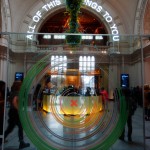Here are my meeting notes from the February 17 meeting of BASTA!: Bridging the Arts, Sciences, and Theoretical Humanities for the Anthropocene
Location: Bittersweet House, 12:00-1:00 pm; approx. 14 in attendance
1. 6X:
We agreed that we should forego organizing anything for this spring and aim instead for the fall. Specifically, we decided to organize something to accompany Elizabeth Kolbert’s Sept. 15 visit to UVM to speak on her book “The Sixth Extinction” (at Ira Allen Chapel). The book will be this year’s UVM First Year Summer Read, which means that many students will have read it. The South End and Burlington Art Hop (SEABA) takes place the preceding weekend. Our idea is to create an event, or set of events, that would allow students, faculty, and community participants to focus on the implications — intellectual, emotional, and others — of mass extinction (i.e., the current “sixth extinction,” as some scientists are calling it), the climate crisis, the Anthropocene, and our individual, community, and societal responses to these challenges. The BASTA! events will take creative, artistic, and/or otherwise engaging forms to create a space for dealing with issues (and emotions) that arise as we think seriously about these interconnected challenges. Ideally, the event(s) will connect both with the Art Hop and with Kolbert’s appearance at UVM. Themes that arose in our conversation include those of grief/grieving, witnessing, helplessness, adaptation, plasticity (including the plasticity of nature/humanity), collective action, and celebration. We will work on planning this further at the next meeting.
2. BTV PHENOxCLOCK:
A related idea that gained strong support is that of creating a Phenological Clock for Burlington. This would take the form of an interactive digital and 3-dimensional sculptural installation situated somewhere in Burlington (e.g., Church Street, City Hall Park, the waterfront, Moran Plant, etc.), which would compile observational data about changing seasonal biotic and other activity patterns related to climate change and its impacts. The PhenoClock would allow for participation/interaction by residents of (and visitors to) the city and region, and could be linked with similar efforts in one or more of Burlington’s “sister cities” or Lake Champlain’s “sister lake” communities, thereby allowing for environmental/social justice themes to emerge at the interface of these global connections.
Note that this idea emerged from Natalie Jeremijenko’s visit and workshop in Burlington last fall. See here for information on her PHENOxCLOCK project, including a photograph of the London Phenological Clock at the Victoria and Albert Museum: http://www.environmentalhealthclinic.net/phenologics/ and an accompanying workshop here: http://www.workshops.tegabrain.com/phenclock/
3. To do list:
Continue working on establishing connections with potential participants/collaborators, organizations, and venues, including art galleries (Artsriot, BCA Arts, and New City Galerie have all been mentioned), the Clean Water Culture group (connection: Cami), 350.org (connection: Brian?), Local Motion (connection: Susan?), schools (connection: Kelly?), et al.
RELATED UPCOMING EVENT:
March 26: “Sustainability Mixer” at Artsriot (open to the public)
